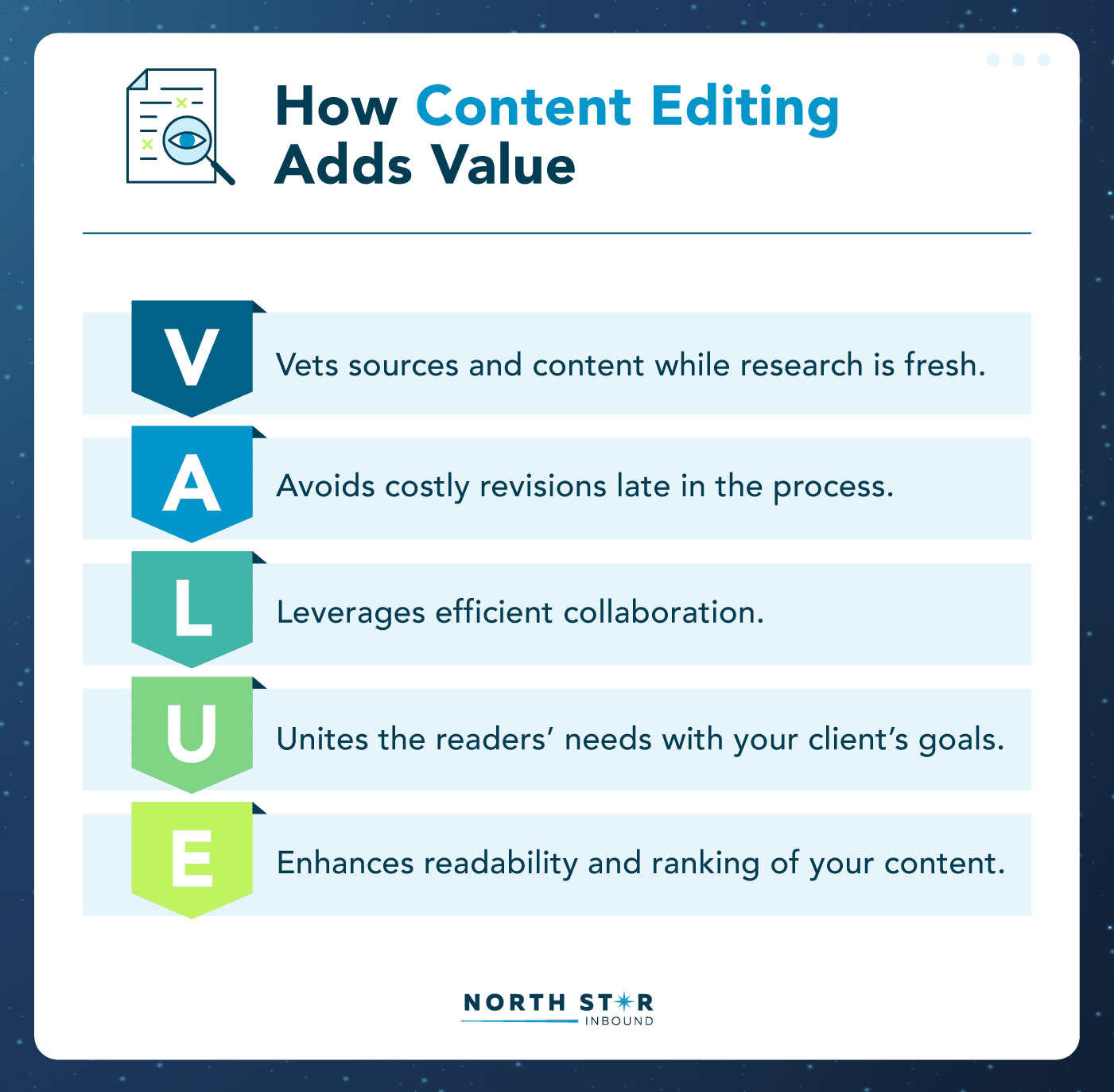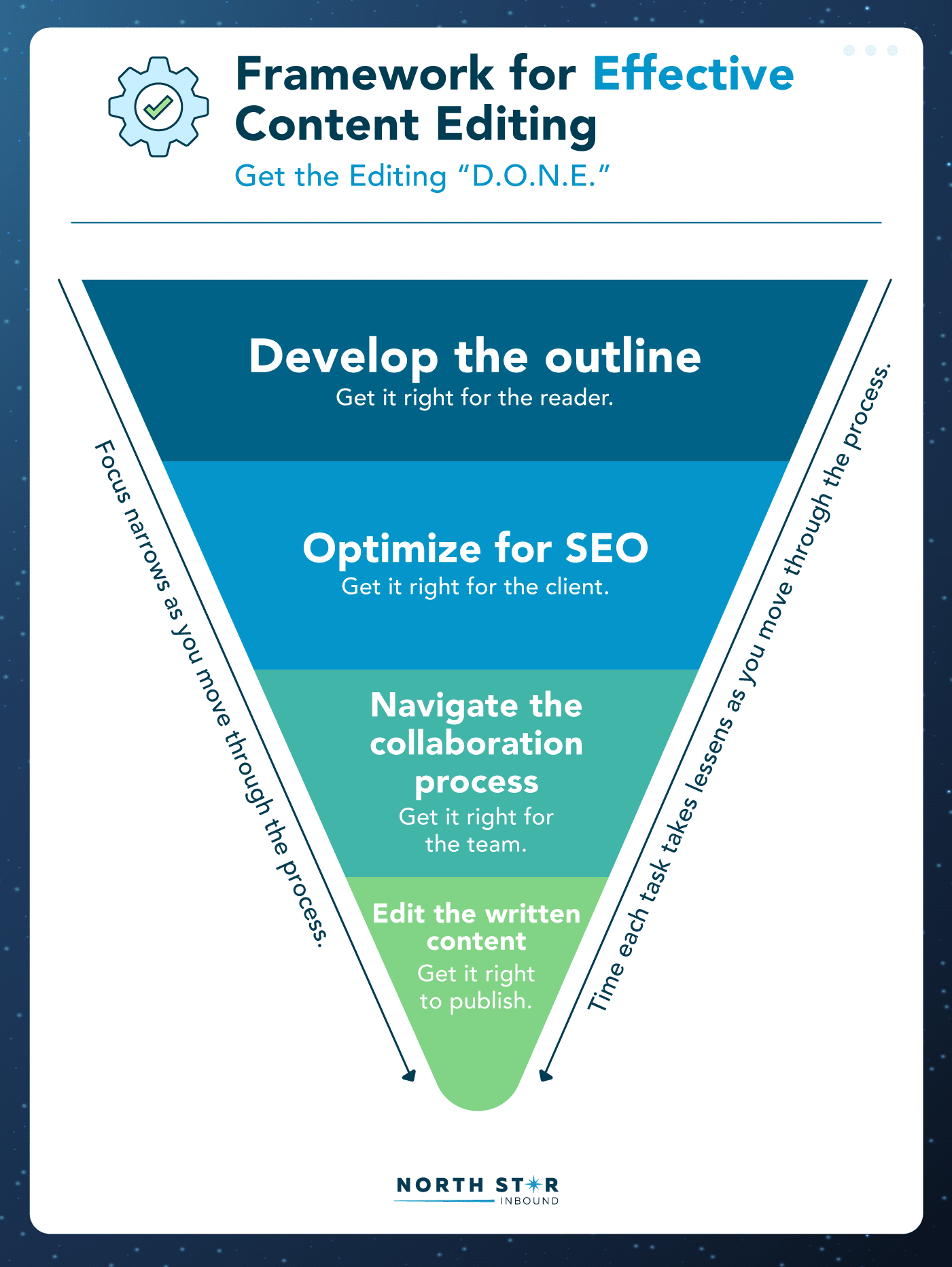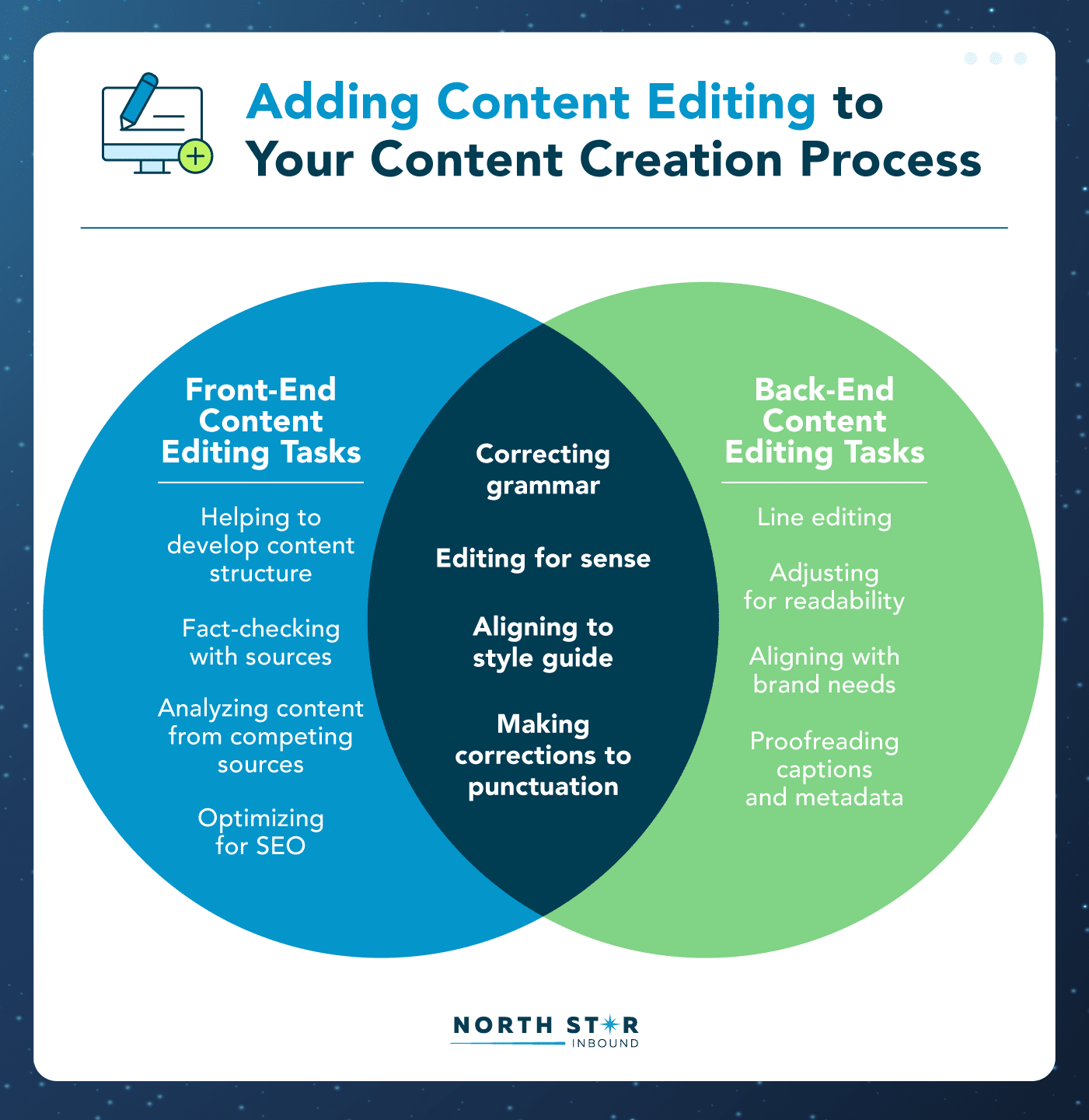Table of Contents
We all know the feeling of clicking on a search result and thinking, “This doesn’t answer my question.” Well, that’s probably because the piece didn’t have a good content editor.
Unlike copy editing, which checks for spelling and grammar, content editing is a more substantive form of editing that helps craft clear, understandable content that balances your readers’ needs with the client’s SEO goals.
All of our posts go through content editing at multiple stages in the creation process to ensure that they thoroughly and thoughtfully answer a user’s query.
In this post, we’ll share our content editing framework with you and explain how you can incorporate it into your process too.
What Is Content Editing?
Content editing is a conceptual process that involves high-level substantive development, collaboration, and SEO optimization. Working within a streamlined content brief process, content editors partner with other stakeholders to create strong, accurate content that helps you become an authoritative source and improves your online visibility.
While thinking about an editor may bring to mind someone just fixing verb tenses in your articles, content editors do much more than that.
Common content editing tasks include:
- Offering substantive edits that develop content structure at a high level
- Strengthening the flow of the text
- Ensuring SEO optimization
- Checking for accuracy
- Make sure content follows brand guidelines, voice, and tone

Content Editing vs. Copy Editing
While various editing types share some tasks, content editing stands out by providing a deeper developmental level than copy editing. Content editors assess readability, accuracy, and coherence, while copy editors fix technical errors such as grammar and punctuation.
Though both editing types are crucial, incorporating thorough content editing enhances workflow efficiency. Performing substantial edits early maintains accuracy and structure, requiring only a light copy edit later on.
Editing encompasses a wide range of tasks that can be split into three distinct types that descend from high level to micro level edits:
- Development editing: Shaping the overall structure and framing of content in addition to ensuring accuracy of information provided
- Copy editing: Correcting grammatical and punctuation errors as well as aligning content to desired style and tone
- Proofreading: Checking for lingering errors not caught in previous steps or errors introduced when tracked changes in content get cleaned up
To better understand the responsibilities of content editing and copy editing, consider their definitions:
- Copy editing: Typically done later in the creation process when the piece is written, this type of editing corrects technical mistakes of grammar, spelling, punctuation, and style.
- Content editing: Typically done throughout the content creation process, this type of editing helps develop the content’s structure, check for accuracy, frame the narrative, and determine what best to include or not include.
This chart breaks down some of the differences between content editing and copy editing tasks.
| Content Editing Tasks | Copy Editing Tasks |
|---|---|
| Helps develop the content structure | Line edits for grammar |
| Researches competing content | Corrects punctuation and spelling |
| Checks sources for accuracy of information | Ensures adherence to brand voice, tone, and style |
| Edits for readability | Proofreads metadata, assets, and captions |
| Suggests additions/deletions for content, accuracy, and sense | Corrects syntax |
| Strengthens the connectivity of the content | |
| Helps to optimize for SEO |
4 Simple Steps to a Successful Content Editing Process
To optimize content development, the best approach is to involve your content editor as a partner from the start. Integrating content editing throughout the creation process streamlines teamwork, enabling efficient production of engaging, SEO-friendly content that resonates with your audience and ranks in search results. You get the job “DONE” in a way that balances everyone’s needs.
A simple framework to follow for successful, effective content editing is:
- Develop the outline. This step focuses on getting it right for the reader.
- Optimize for SEO. This step focuses on getting it right for the client.
- Navigate the collaboration process. This step focuses on getting it right for your team.
- Edit the written content. This step focuses on getting it ready to publish.
Given the conceptual and flexible nature of content editing, tasks might overlap or recur across steps. However, this framework clearly outlines a content editor’s role in each content creation phase. The upcoming sections detail each step of the content editing process.

1. Develop the Outline Before Writing Begins
Encompassing the bulk of the content editor’s job, you should assist in shaping the content to reach the target audience. In this step, the team member putting together the outline hands the project to you for review. Your focus is the reader, so you should concentrate on adjusting the flow and structure to speak to your reader with clarity and to provide them with accurate information.
Crucial for content creation, this step benefits your entire team by:
- Addressing high-level issues while research is fresh, enabling quick adjustments to structure
- Giving you more freedom in the back end to perform a thorough line edit of the post
- Preventing costly revisions and that disrupt fully written pieces with significant late-stage changes
As you walk through each task in this step, make sure you’re always keeping the perspective of the reader. These questions should guide your editing and reflect back to the quality of the outline:
- Does this outline offer this specific reader the information they want and need to know?
- Are these the best, most authoritative sources for this information?
- Do the outline and headings show the reader we are meeting their needs?
- What might the reader be left wondering about?
- What actions does the outline encourage the reader to take and are good examples given?
- How is this unique — how does it offer different perspectives, frame the discussion different, or provide better, more accurate information?
- How does this align with the client’s needs and brand?
For the most efficient use of your time, content editors should follow these tasks in order during this initial step:
- Analyze the sources and top competing posts. Before you dive into the outline, check out the foundation on which it was created — the sources and the competing posts.
- Check the structure of the outline. Ensure the most important information is at the top and determine if the outline answers the reader’s questions.
- Review the headings. Look at the language and message of the headings. Make sure headings are framed in reader-first language and that they connect to the overall message. They should reflect back to the main topic and be relatable to the reader.
- Read the content directives. Directives instruct writers on content scope and depth. See that directives connect clearly to corresponding headings and use authoritative sources for support. Also ensure that directives engage readers with actionable steps and thought-provoking ideas
- Review the content for visual variation. Restructure dense paragraphs by introducing visual breaks. Utilize bullets, numbers, charts, and visuals to enhance readability and comprehension for readers.
- Clean up obvious text errors. Make sure any included text conforms to the brand guidelines and that you correct obvious grammar and spelling errors. Although not the primary focus here, addressing these errors now establishes the right tone and can lead to fewer corrections later. Begin adding notes to your conventions sheet, your internal document that lists standardized spellings and style points that you frequently encounter with clients. This document serves as a valuable resource for your team and your writers.
2. Optimize for SEO
Developing the outline for the reader goes hand-in-hand with optimizing for SEO since Google takes a user-first approach. As you’re content editing, make sure the brief or article follows SEO best practices like including appropriate keywords and internal links.
Oftentimes comments related to SEO optimization tie back to search intent. Is the structure of the piece answering the user’s primary question and related questions in an easy to navigate way?
While addressing the tasks in this step, ask yourself these questions:
- Are we targeting related pages with internal links?
- Are keywords and internal links used organically and bringing clarity to the post?
- Are related keywords helping to flesh out subtopics and headings?
With a solid structure in place, you can perform the following tasks in this step:
- Check internal links. Look at both the links and the suggested anchor text to ensure they can be organically inserted into specific sections of content.
- Assess the use of keywords and related keywords. Ensure that keywords and related ones are used effectively and organically in headings. Check to see that they help map the path of the post and aren’t overused in the structure.
- Review the metadata. At this point, title tags and alt text should be pretty straightforward, but development editors can really shine at helping mold the meta description. Because it needs to convey the idea of the post clearly but in a limited number of characters, content editors tend to have a knack for making this happen.
3. Navigate the Collaboration Process
As the person who marks up someone’s hard work, it’s easy for the editor to be seen as the enemy. That’s why offering clear feedback, posing questions, and encouraging dialogue is essential for a productive editing process. That way, everyone can work together to clean up edits, clarify text, and finalize the content brief.
To create quality content in a collaborative way, you have to properly frame your feedback for others so that the creation process doesn’t halt over hurt feelings, misunderstood directives, or confusion. Your feedback should not only seek clear answers but also help others learn and apply your feedback to future content, ensuring a smooth creation process.
To effectively collaborate with your team, ask these questions during this step:
- Am I helping to enhance the content with this suggestion or question?
- Are my suggestions or questions clear and concise?
- Am I supporting my team in the way I framed the feedback?
- Do I offer problem-solving suggestions instead of just pointing out problems?
- Do my words show empathy and acknowledge the work my team has put into the post?
- Can my feedback apply to future posts?
To ensure you offer clear feedback and get back clear answers in return, make sure you check off these tasks to encourage effective collaboration:
- Ask for your teammate’s perspective. Not only should you be offering a glimpse into what you think about an element in a post, you should invite your teammate to add their perspective as well. Doing so encourages teamwork and inclusion and supports everyone’s ownership in the process.
- Offer explanations. When you make large changes, tie them into editorial or SEO standards or client needs. These three parameters drive your content, so making a change that better aligns with these standards should be highlighted and you should explain the “why” behind your feedback.
- Start a conversation — don’t simply point out a confusing item. Collaboration requires conversation, so don’t just offer a comment that something is confusing, explain why or just end with the simple phrase, “What do you think?” This leaves the door open for clarification and effective collaboration.
4. Edit the Written Content
If your content editor already helped develop the structure from the beginning, they know what to expect when opening the document for editing. The writer should have followed the structure and used the supplied sources, making this step just line editing for your content editor.
Because of the upfront work, content editors don’t have to substantively edit the piece at this point. They can focus on details, correct errors, and have more time to polish the piece for SEO optimization and readability so both the client’s as well as the reader’s goals are achieved.
In this step, the tasks are even simpler, just editing the post for:
- Readability
- Grammar and punctuation
- Syntax and sentence structure
- Errors in metadata, assets, and captions
- Adherence to brand voice, guidelines, and tone
Why Is Content Editing Important for SEO?
If you want your content to rank and reach users, you need content editing. Because content editing targets both the readability of the text as well as its SEO framework, your content is developed to exceed expectations for both readers and bots.
Juggling multiple projects and different clients, you stay extremely busy. So having a content editor weighing in throughout the creation of content helps to streamline your process. With a dedicated focus in each step, editorial tasks won’t fall through the cracks or be chaotically lumped together at the end of the process.
Content editing offers you confidence in your creation process, confidence that your content will engage readers, meet their search intent, and guide them through the sales funnel. When you have a good content editor, you have someone ensuring the accuracy of the information and the readability of its presentation to the reader.
How to Fit a Content Editor into Your Creation Process
For many businesses and agencies, an editor performs substantive editing, line editing, and proofreading in one step in addition to SEO optimization. But using your editor so late in the process means they have to prioritize the tasks that need to be done, often leaving other tasks to fall through the cracks.
Typically, you don’t have a team of editors specializing in one part of the process, so you can use a content editor most effectively in both the front and back end of your content creation process. By dividing up the tasks this way, all tasks are already prioritized so nothing is left to fall through the cracks.

| Front-End Content Editing Tasks | Back-End Content Editing Tasks |
|---|---|
| Helping develop content structure | Line editing |
| Fact-checking with sources | Adjusting for readability |
| Analyzing content from competing sources | Aligning with brand needs |
| Optimizing for SEO | Proofreading captions and metadata |
What You Need in a Content Editor
To create the highest quality content, you need a professional editor who can collaborate effectively with your team. Like anyone on your team, you want someone who can manage time well, understand SEO principles, be decisive, and pay attention to detail, but your content editor brings a unique set of skills to your team.
You need someone who can:
- Quickly internalize information
- Understand content structure at a high level
- Efficiently communicate structural needs
- Effectively research
- Easily adjust to different client content and different audience needs
- Can solve problems with content in a way that meets client and reader needs
- Spot grammar and syntax errors
Need Help Creating Quality Content?
If you want to create high-quality content that resonates with readers and ranks in a search, take advantage of our content marketing services. With team effort of our content strategists and development editors, we apply a detailed process to create content that delivers.





